Tool 13: Participatory action research
Participatory action research
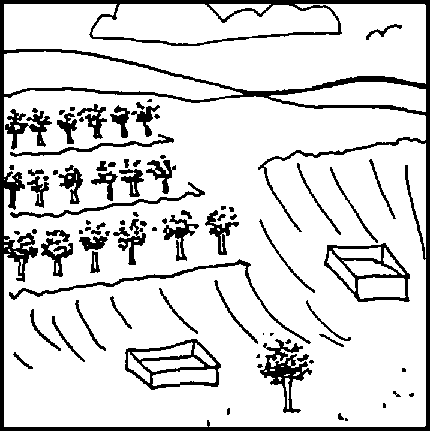
Tool description
Participatory Action Research is a continuous cycle in which insiders and outsiders together decide what needs to be researched, design the research (what will be measured and how) and collect the necessary information. This information is then put into practical applications or used to identify new research ideas.
Three examples of Participatory Action Research are given here: Yields, Soil Traps and Research Plots. Basic to all is a consistent, comparative and/or systematic measurement which shows the effects of the activity or intervention.
| Yields | Farmers measure and record information. A separate booklet may be provided, or a section can be provided in the Farmers' Own Records(Tool 15). |
| Soil Traps | This is a physical structure established to monitor effects of activities which may have an effect on soil stability. A number of strategically located soil traps or soil sticks are constructed so that soil movement can be periodically measured and recorded. |
| Research Plots | Insiders and outsiders are involved in setting research priorities, and designing research plots. Research plots can be either central or on individual farms. |
| Central plots are located in an area with high local visability, and generally focus on research that has a high risk to farmers, but that is potentially of great value. Responsibility for inputs and recording of measurements can be shared between insiders and outsiders. These plots are easier to manage and seen by some as more "scientific". | |
| Individual research plots are established on farm lands, with farmers taking measurements and keeping records. The information from the many plots is then added up and/or compared. The information from farm research is often more realistic and useful, because it involves real farm situations, shows variation in sites, is more realistically managed in terms of labour inputs, and may facilitate better farmer to farmer interaction. A disadvantage is that records are kept by each farmer, and there may be variation because of this. |
Purpose of the tool
• Locally test new technologies (species, management practices, soil conservation measures, etc.)
• Determine the effectiveness of interventions after trees are planted
• Support and strengthen indigenous research skills
Major benefits
Research relevant to the real needs of farmers is identified and can be further developed by outside research agencies.
Supports and strengthens existing local research.
Farmers are aware of the changes (positive or negative) brought about by a change in former practices.
Participatory Action Research lowers the risks associated with large scale promotion and adoption of new, locally untested technologies.
Using the tool
1. Arrange a meeting with relevant community members to discuss: which interventions and management practices they wish to test; what methods they wish to employ; (ie: whether it will be a test/control plot, or yields before and after treatments); the terms of measurement; and the method of measurement
2. Some examples are:
| Soil Traps | small pits of the same size can be dug and reinforced with some solid material. Soil traps can be located below fields where there has been a forestry intervention (for example, contour lines planted with trees) and in similar places below sites that have not had any interventions. |
| Soil Sticks | sticks with measurements carved or coloured on them are firmly placed in the ground below similar fields with and without interventions. The measurements on the stick are recorded. |
| Research Plots | whatever is being researched, there should be a "test" plot and a "control" plot that are as similar as possible in all aspects except the one factor that is the subject of the research. |
| Yields | conducted to measure the effects of an intervention (alley cropping, windbreaks, boundary plantings, etc.) on crop yields, and/or to measure the outputs from the intervention (poles, fodder, firewood, etc.) The areas where measurement is being made should be as similar as possible. |
3. Insiders and outsiders design the monitoring format for this tool. This could be a separate booklet or card, or an insert to Farmers' Own Records.
4. Information from Participatory Action Research is shared and analyzed by insiders and outsiders together, and the results used either to change existing practices, not change existing practices, and/or call for further research.
Precautions in using the tools
The attention that is paid to the selected farmers may induce them to apply more attention to the test plots (weeding, watering, etc.) than to the control plots, biasing the information.
Other factors that might influence research must be considered (ie: unusually heavy rains over one year might result in heavy erosion; use of improved crop seed could improve harvests; years the land has been fallow could affect productivity).
Results over the long term will increase accuracy, and decisions should not be made on a few years results.
Maps and mapping
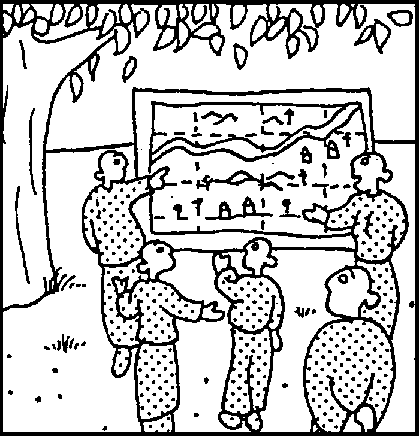
Tool description
This tool uses purchased maps, maps produced by the group and/or aerial photographs to assist with community land use planning and monitoring changes in land use.
Purpose of the tool
• Monitor changes in land use
• Assist insiders with planning and designing
• Evaluate changes in land use through comparison
Major benefits
This tool can give a broad overview of the evolution of community land use. It is thus useful for planning and monitoring community forestry/watershed areas.
It is less time consuming than other information gathering tools as many different interventions can be identified using the one tool.
Communities, some for the first time, can analyse the linkages, patterns and inter-relationships of land use.
Maps and mapping can be a multipurpose tool, useful for Extension, Assessment, Planning, Monitoring, Baselines, and Evaluation:
Using the tool
1. Introduce both the concept of maps, mapping, and/or aerial photographs, and the purpose of the exercise to groups of 5-7 persons. These small groups can be composed of representatives of different groups within the community, or different interest groups can do the mapping separately and then compare them.
| Aerial photographs may be expensive if not readily available. Local maps or purchased maps can be used, or the community can draw the map themselves (see Tool 2: Drawing and Discussion), in which case expenses are minimal. |
If this tool is used for planning, the various activities can be drawn in on the map/photograph or overlayed.
If this tool is used for monitoring, changes can be recorded on the maps/ photographs periodically.
If this tool is used for evaluation, a comparison of maps and/or photographs at different times will be most useful.
2. If using aerial photographs or maps, common landmarks are first identified (local names for lakes, rivers, roads, buildings,) and other areas are then identified relative to these.
An overlay can be used on an aerial photograph, to sketch in the areas of importance (communal grazing lands, private farms, state forest, etc.)
3. There are a number of different ways mapping can be organized. For example people can (separately or in groups) draw their own maps of the community, and these can be compared and synthesized into one large map. This may be especially useful if different interest groups in the community are involved, as they will have different perceptions of land use. If activities affect the different interest groups each of their perceptions should be recognized in order to begin successful negotiations.
4. For microfarm planning, separate maps can be created by individual farmers (for either planning, monitoring and/or evaluation) and then combined on a larger community map.
5. It is important to use good quality maps or paper, and keep them in a safe place for future reference.
Precautions in using the tool
Aerial photographs may be difficult to obtain, and/or expensive to buy. They may also be difficult to read and interpret.
A comparison of individual maps may bring out feelings of inadequacy, or unwillingness to acknowledge specific ownership of land.
Conflicts may result if inequities become apparent, or old hostilities are rekindled.
A cross section of the community is required to validate the overall community perceptions.
One person may dominate or direct drawing if mapping is done by the group as a whole.
Farmer's own records
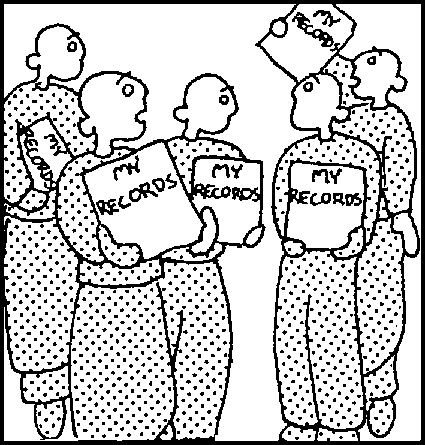
Tool description
A farm or community record booklet containing simple procedures to monitor information can be designed by insiders and outsiders to suit a specific area and situation. Monitoring indicators and terms of measurement are chosen by insiders. The recorded information is useful to individual farmers, when synthesized it is valuable to other farmers and outsiders.
Purpose of the tool
• Judge whether the activities (new species, new methods of management, etc.) are beneficial to the farmer
• Test and compare old practices with new practices
• Define future research and development priorities for improving the technology
• Provide an "early warning system" for new, locally untested technologies
Major benefits
Farmers can see and judge for themselves, from their own information sources, the benefits or disadvantages of activities.
The tool can be modified for use in all types of forestry activities such as agroforestry, compound plantings, fodder banks, community woodlots, and small scale forest based enterprises.
The tool can monitor inputs (seed, fertilizer, tools, labour) and outputs (crop yield increases, polewood, fodder, secondary forest products).
Monitors what the farmers' perceive as important inputs/outputs.
The tool provides "on-farm" research information which can be compared between farms (communities) and help to identify future research priorities.
Provides site and situation specific information in a consistent format.
Using the tool
1. Insiders first identify their reason for keeping track of information. Then, the overall method that will be appropriate for the purpose and the situation; what will be measured; and the terms of measurement (for example, bags or kilos, labour measured by half-day or by the hour).
2. Insiders and outsiders design a record keeping booklet (this may be only one page, or a number of pages, depending on the situation) that will meet their information needs. After being drafted, the booklet should be reproduced on sturdy paper, with strong binding.
If literacy is low, drawings can be substituted for writing, and pencil strokes for measures as shown below, where time spent working in various activities was recorded. By making one mark for every half-day spent doing specific jobs, a farmer can compare the time worked on the control plot with the time spent on the test plot.
Sample of farmers own records
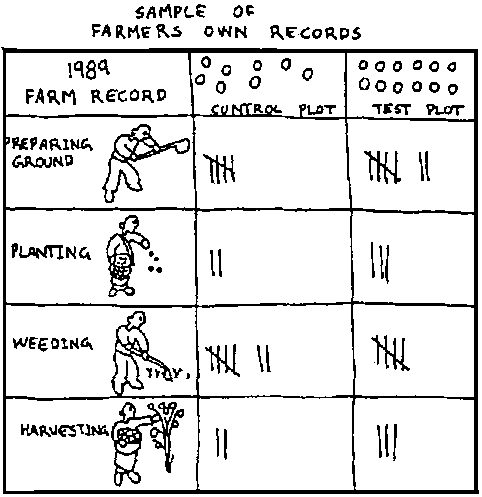
3. Produce the appropriate number of record keeping booklets and distribute them to beneficiaries with a short familiarization session.
4. Consistent follow-up and evaluation of the utility of the tool is necessary to encourage its continued and systematic use over time.
5. Meet periodically to synthesize, compare and discuss the results.
Precautions in using the tool
The results may be somewhat general if the tool is used to assess activities and/or technologies which are being used over a wide area.
There should be space in the booklet for recording unexpected factors.
The booklet should be designed and produced and analysed with input from insiders.
Nursery record book
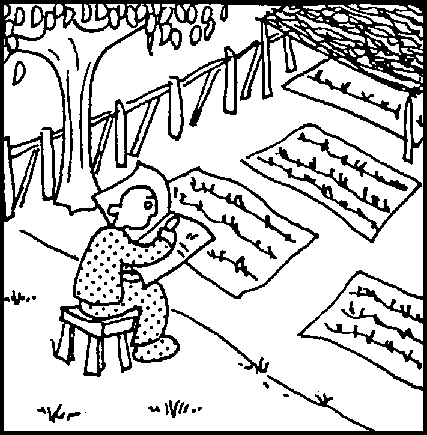
Purpose of the tool
A record book is maintained by either the community nursery committee, a community representative, or a paid nursery worker. It records what the insiders feel is important information. This may include cost accountability, a record of technical information, species preferences, labour inputs, etc.
Major benefits
• Assist and improve nursery administration
• Retain valuable information about new nursery and disease control techniques, sources of seeds, etc
• Keep track of seedling distribution for future follow-up
• Keep cost accounts
Major benefits
This tool helps insiders with new or untested nursery practices.
Can identify nursery research needs.
Helps to establish effective nursery techniques.
A record book is maintained by either the community nursery committee, a community representative, or a paid nursery worker. It records what the insiders feel is important information. This may include cost accountability, a record of technical information, species preferences, labour inputs, etc.
Using the tool
1. Meet with insiders and/or the nursery committee to discuss which information to collect, and to choose a person responsible for record-keeping.
2. Set up the record book according to the information needs discussed and agreed upon. An example of a nursery record book is given below:
SAMPLE OF NURSERY RECORD BOOK
| DISTRIBUTION RECORD | ||||||
| DATE | NAME OF FARMER | LOCATION | SEEDLING | INTENDED FUNCTION | REMARKS | |
| No. | SPECIES | |||||
| OPERATING COST RECORD | ||||
| DATE | ITEM MATERIAL | QUANTITY | COST | REMARK |
| LABOUR RECORD | |||
| DATE | NAME | ACTIVITY | HOURS |
3. Provide follow-up and assistance as required.
4. Hold periodic larger meetings to provide feedback to the community.
Precautions in using the tool
Outsiders should ensure that they do not force their own information on insiders.
Tool 17: Community financial accounts
Community financial accounts
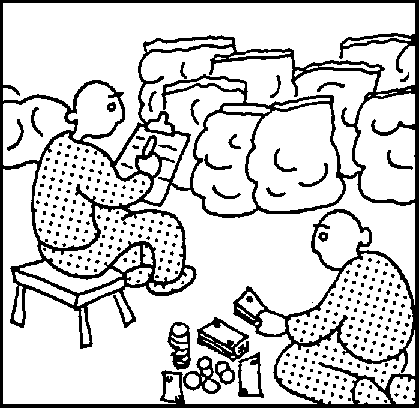
Tool description
This tool utilizes basic single-entry bookkeeping techniques (receipts, input/output columns, etc.) to record and monitor financial information.
Purpose of the tool
• Monitor the finances of small-scale forest based enterprises
• Provide accountability to the community
• Assist in evaluating the inputs/outputs
Major benefits
Helps insiders identify financial problems quickly.
Assists insiders by providing information on which to base financial management decisions.
Develops and/or strengthens insider record keeping skills.
Using the tool
1. Meet with insiders to discuss which information they need, identify the probable inputs and outputs, where the information will come from, and who will be responsible for the accounts.
2. Design a record keeping system that will easily provide the information needed.
3. Follow-up and assist with record keeping for ongoing accounts, balancing and reporting results to the community.
Precautions in using the tool
The bookkeeping should be kept as simple as possible.
Tool 18: Strengths, weaknesses, opportunities and limitations (S.W.O.L.) analysis
Strengths, weaknesses, opportunities and limitations (S.W.O.L.) analysis
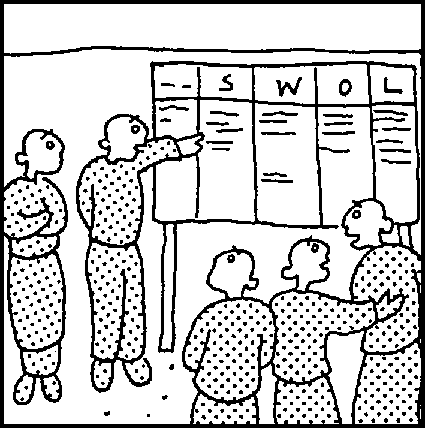
Tool description
This tool provides a framework which allows for group analysis and/or evaluation of issues. Four categories (Strengths, Weaknesses, Opportunities and Limitations) in the framework are used to examine, define, discuss and record the issues.
Purpose of the tool
• Provides a framework for analysis of a given situation
• Encourages input from many people
• Facilitates discussion of potential solutions (opportunities) and constraints (threats)
• Gathers qualitative information
Major benefits
Field staff have found the S.W.O.L. Analysis easy to explain, easy to use, and easily understood by communities.
This tool can be used in information gathering and analysis for Assessment, Monitoring and Evaluation.
The best thing about this tool is that it recognizes that there are usually two different sides (positive and negative) to any given issue or situation and it encourages discussion of both. It helps to set the basis for negotiations and trade-offs.
Open, in-depth, focused and frank discussions are facilitated because agreement must be reached to identify what is a strength and what is a weakness. What is seen as a strength to one person may be a weakness to another.
Encourages thinking about creating opportunities, considering strengths and weaknesses, and the limitations that might be present.
This tool allows for ALL ideas around a specific issue to be discussed.
Used consistently over time, this tool can record changes in attitude and perception.
Using the tool
1. Approximately two hours will be needed to explain the tool to participants, go through the exercise, analyze and synthesize the information.
2. Materials required are large paper or newsprint and big pens, or chalk and a blackboard.
3. Explain the purpose of the tool. Decide on the issue or situation that will be discussed. The issue or situation can be broad or narrow, S.W.O.L. analysis can handle most issues, as long as they are clear and understandable.
4. Explain the categories to participants. Description of categories is as follows:
| Strengths | Strengths are those things which have worked well, the things that you are proud to tell others, that you like to "brag" about! Strengths are the best aspects of any given situation, issue or persons. |
| Weaknesses | Weaknesses are those things that have not worked so well, the things that you would rather others didn't know about! Weaknesses are the inferior aspects of any given situation, issue or persons. |
| Opportunities | Opportunities are the possibilities for positive change, given both the strength and weaknesses. Opportunities are the chance to change things for the better. |
| Limitations | Limitations are the things that stop us from realizing the opportunities. Limitations stop change from happening. Some limitations can be overcome, others cannot. |
| TOPIC | |||
| TOPIC: EVALUATION OF NURSERY | |||
| STRENGTHS | WEAKNESSES | OPPORTUNITIES | LIMITATION |
5. As the four categories are being explained, write them at the top of the columns across the top of the page. Leave space to insert the main points of discussion as shown in the sample below.
6. There are two ways to approach the S.W.O.L. Analysis, depending on the specific situation or issue. Either go through all the strengths first, then all the weaknesses, all the opportunities, and all the limitations. Or identify each strength, then each "matching" weakness, and so on. A small "test" of the tool use will help you to know which approach is going to work best in each instance.
7. Some points may be discussed at length before agreement is reached. Each point is written on the framework only after agreement has been reached.
Precautions in using the tool
Sensitive subjects may arise. The facilitator may wish to change the topic and return to the sensitive point later on. This can reduce the chance of possible problems.
Some of the group may dominate discussion. The facilitator can ask specific persons for input, or the exercise can be done with different focus groups.
Synthesizing discussion into a few words may be difficult. The facilitator should always check to see that the audience agrees with the reporting.
Popular theatre
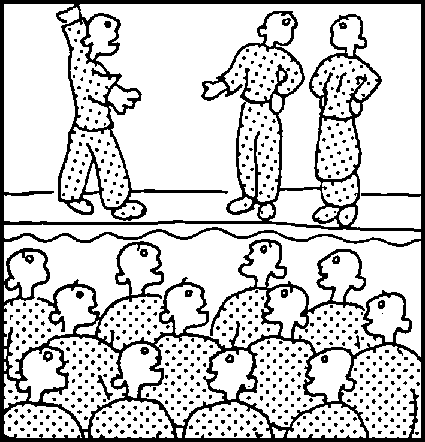
Tool description
This is a tool to develop awareness through the use of local media such as dance, song, drama and mime. Popular Theatre is different than traditional theatre because rather than mirror and mimic the culture, it shows the contradictions, leaving the audience with unanswered questions upon which to reflect and hopefully seek answers.
Popular Theatre is not meant to produce a masterpiece, it is a tool to better understand a situation.
Purpose of the tool
• Express feelings, tell a story, or bring up community concerns around an issue
• Use the potential of theatre as a "rehearsal for life," helping to overcome fears and build confidence
• Encourage the audience to reflect upon and seek answers to community problems
Major benefits
This tool is multipurpose. It can be used for Assessment, Evaluation and Monitoring. It can be used often throughout the project to build a story. It can be used to present the "results" of analysis, and have those results verified by a wider audience. It can be used to present (through video, slide tapes or tape recordings) information to other communities, other decision makers and/or other interested parties.
This tool encourages a high degree of community/beneficiary participation, identifying community concerns and working towards solutions.
Overcomes fears and builds confidence.
Using the tool
1. For a fairly elaborate presentation this tool requires some time. However, if the community is familiar with their chosen form of communication it may be done fairly quickly and easily. Expenses are minimal if locally available costumes and props are used. If recording is done (photographs, slides, video, tape recording) it can be more expensive.
2. Training in the use of Popular Theatre is recommended. Experience has shown that once a group is presented with the idea, they enthusiastically proceed. An outside popular theatre group may be used to facilitate presentation if local expertise is not available.
3. There are four basic steps involved in producing popular theatre:
| Taking in: | Create an atmosphere in which insiders and outsiders can feel free to talk openly of experiences or problems which are painful, difficult or taboo to discuss. Most people begin by exploring their own experiences, and later begin to study experiences of others. |
| Analyzing material: | Analysis is done by discussions between insiders, outsiders and animators/actors/facilitators. In discussions the information about the issue is examined in its wider social, economic or political context. This approach brings to light the relationships and contradictions between problems. |
| Creating material: | Convert the major issues into entertainment. This entertainment can be in the form of a series of workshops, or a play. Activities can be structured into entertainment by: |
| Asking people to take on the role of a group or community unfamiliar to them and to feel and reflect on the experience. For example, an urban group may be asked to experience, or act the pan of members of a rural group, or men may be given roles as women. When people take on very unfamiliar roles they are forced to learn and explore new feelings and experience. | |
| Building the new thoughts and emotions that are learned into stories or scenes for a play. This can be done by incorporating ideas into the narrative for a drama or shaping it into a discussion between the actors and the audience. | |
| Reflection leads people into the next and important stage, "rehearsal for life" where there is the opportunity to create a theatre situation where people "practice" change and new perceptions emerge. | |
| The participants or audience are asked to intervene to solve a problem or resolve a contradiction. By resolving the contradiction, the drama reaches a new phase, and becomes a new drama. This new drama may have new contradictions built into it and so the process becomes continuous. | |
| All of these stages can take place in the natural setting. They do not require a traditional theatre nor all the trappings of a theatre such as scripts, sets, costumes and lighting. | |
| Organization: | A vital pan of Popular Theatre is organization of a small group of people that work well together, and understand the community of people. This group is responsible for developing ways for the community to participate in the analysis and decision making that is central to the work. The group guarantees that resource people/animators and writers remain in touch with the feelings of the groups with whom they work, and vice versa. |
Precautions in using the tool
It may be difficult to record the process and the outcome especially if there is a great deal of audience response. Tape recordings, photographs, or videos may be useful for recording.
Actors have to "create" quickly, based on audience response.
The entertainment value should not outweigh the learning value.
Puppet theatre
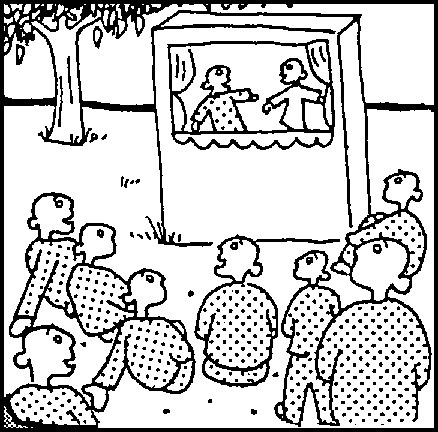
Tool description
Puppets are used to represent characters which act out the issues and/or story determined by insiders. If an outside professional puppet group is used, the assistance of insiders to develop scripts around the issues is required.
Purpose of the tool
Puppet theatre has the same purpose as Popular Theatre (Tool 19), but because the puppets are not viewed as "real people", they can often deal with sensitive situations and more easily obtain feedback from the audience.
Puppet theatre has high entertainment value in some cultures, and can reach and receive feedback from a wide audience.
This tool is multipurpose. It can be used for Assessment, for collection of qualitative information; as an extension tool, and for presentation and communication of results.
By using this tool continually, an ongoing process of audience feedback exists. This strengthens the group analysis.
Using the tool
1. Meetings of insiders/outsiders and the puppet group (if applicable) will be needed to identify key issues, and design a presentation that will encourage response. After the messages and key issues to be communicated are identified, it should be determined how this can best be done. For example the puppets can tell a story or act out a drama
The puppet group will require manual dexterity, voice and story telling abilities. If local people are going to be the puppet group, they may require some training and rehearsal.
2. Construct puppets and stage if not available. To build puppets and stage, local materials should be sought: gourds can be used for puppet heads, stages can be made of local cloth and scrap wood, and lighting systems can be constructed from old tin cans. Often, however, these are not of good quality and materials have to be purchased.
3. Select characters and begin designing the script.
4. Rehearse the shows with a small group playing the role of audience.
5. Present the puppet show to the larger group. Record responses so that they can be used to develop the message and story in the future. See Popular Theatre (Tool 19) for funkier suggestions.
Precautions in using the tool
Puppeteers must handle a variety of unexpected and often sensitive responses.
Recording the responses for future use may be difficult. A tape recorder can help, or a number of people can take notes.
Ensure that the messages/issues are relevant to the community (there is one example of a puppet group which encouraged farm tree planting to a group of landless people!). When the issues and messages are decided upon by insiders, this problem is reduced.